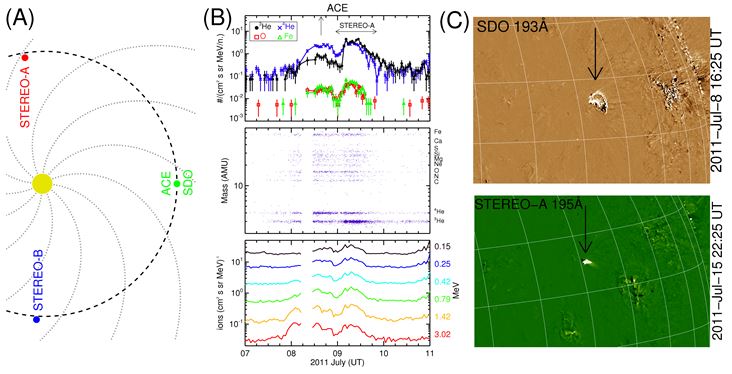
(A) Positions of STEREO-A and -B in the ecliptic plane in July 2011. (B)
(upper panel):1-hr ACE/ULEIS 0.23-0.32 MeV/nucleon 3He,
4He, O, and Fe
intensities. The arrow indicates an extreme ultraviolet (EUV) jet in newly
emerging AR 11246. Double-ended arrow denotes the STEREO-A 3He-rich period
shifted in corotation time. (middle panel): 0.4-10 MeV/nucleon ULEIS mass
spectrogram. (lower panel): 1-hr ACE/EPAM ion intensities from LEMS120. (C)
5-minute difference EUV SDO/AIA (upper) and SECCHI/STEREO-A (lower) images.
The arrows point to the jet in AR 11246.
Since February 2011 STEREO-A and -B, along with near-Earth spacecraft
(s/c), have provided for the first time a view of the full solar surface. This
allows continual tracking of solar active regions (ARs) for their entire
lifetime. With the advantage of a wide angular separation between the two
STEREOs and the near-Earth ACE s/c, we report first time observations of
multiple 3He-rich solar energetic particle (SEP) injections from the same
AR for a relatively long time period lasting at least a quarter of a solar
rotation. We identified two long-lasting 3He-rich SEP sources, one relatively
large AR 11244, accompanied by B-class X-ray flares and another small, newly
emerging AR 11246 near the border of a low-latitude coronal hole that produced
numerous jet-like emissions. 3He-rich SEPs associated with AR 11244 were
consecutively observed by STEREO-B on July 1 and ACE on July 8 and with AR
11246 by ACE on July 9 and STEREO-A on July 16. Previous single s/c
observations showed such energetic ion bursts over relatively short time
intervals (< one day) presumably due to loss of magnetic connection to the
flare site. These new observations reveal that conditions for particle
acceleration in a single solar region may pertain for a long time, implying
that the processes are more continuous than previously thought. For further
details see Bucik et al. Astrophysical Journal, Vol. 786, 71, 2014.
This item was contributed by
R. Bucik (Max-Planck-Institut für Sonnensystemforschung)
and G. M. Mason (Johns Hopkins University, Applied Physics Laboratory).
Address questions and comments to
ACE News Archives
Subscribe to ACE News
ACE Homepage
Last modified 29 May 2014.